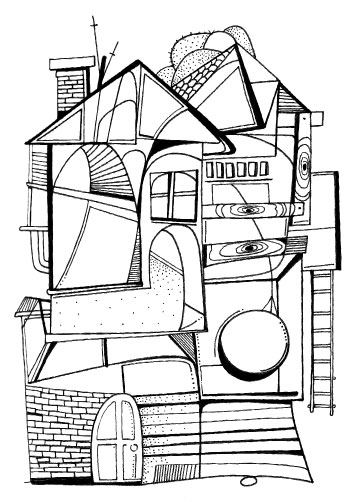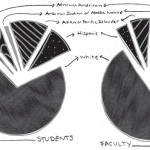Unmet needs and recent improvements in academics and student services
In the May issue of F Newsmagazine we published responses from students, faculty and staff to our F News Question “What changes and/or improvements would you like to see at SAIC?”
For this supplement, we decided to extend our inquiry to the administration — soliciting input on what improvements are being made and what changes still need to occur within specific academic and student services departments.
Those who responded had many valuable points to make. Here, in no particular order, are all of the responses we received.
Leave your response in the comments below!
Career Services and Alumni Relations
Emily Chapman, Director of Alumni Relations
One of the best parts of my job is meeting alumni and hearing about all the interesting things they have been doing since they graduated. Some of them have been out of school for 50 years, so they have a lot to share — not only about the things they have accomplished, but also about what SAIC used to be like 50 years ago. A lot has changed between now and then!
I would love to find more ways to share the interactions I have with alumni with current SAIC students. SAIC alumni have so much to share about what life is like after school; their experiences can help current students on their paths to becoming successful artists, designers, writers, business owners, critics, curators, educators, administrators, film makers, performers and so on.
We have an alumni website where a lot of our SAIC Alumni Accomplishments are posted (mysaic.edu), as well as a Facebook fan page (facebook.com/saic.alumni) and Twitter feed (twitter.com/saicalumni). I would like to see more students visit us online and interact with the alumni community.
Student Financial Services
Patrick S. James, Director
The Student Financial Services office is always striving to improve customer service and satisfaction, and must always continue to do so. The world of financial aid has continued to be more complex with new rules and regulations. We need to be as available as possible to assist students in navigating through the process.
One way we do this is by improving efficiency in the office so the staff has greater availability to advise students and families. Last year, we were able to improve efficiency by automating the awarding process for the 2009-10 year.
Before that, we were manually calculating these awards individually, student by student. This required many hours and months to accomplish. This new process allowed us to get awards out sooner than ever while freeing up the time it took our staff to manually prepare these award packages.
Cooperative Education Program
Vicki Engonopoulos, Director
I would like to see larger offices that would create a communal space for our students to hang. Add color to the walls. Make sure that each student is aware of the Co-op program and the pathways it can create.
Campus Life
Shannon Delaney, Director of Campus Activities
Even though we are in a spot where we have multiple searches happening, I still think the institution is going in a good direction. It has been great to hear the progress that is being made with defining SAIC’s core values and creating the strategic plan.
I think people are having candid and fruitful conversations about that across campus. As a staff member, I am very interested to see where that leads us. It saddens me that Duke won’t be here to see that all through, but I don’t get the impression that we will stop progress on these projects in his absence.
As for Campus Life, I think we face similar struggles as other departments. We do the best we can with what we have. We are very fortunate to have such a dedicated group of staff members who really want to do anything and everything that they can for students.
I think we all wish we had more hours in the day and more staff to help us provide more events, programs and services to students. But, like I said, I think there are many offices who would say that same thing and I think we all realize that isn’t always possible.
Multicultural Affairs
James Britt, Director
I don’t think improving Multicultural Affairs is incumbent upon external changes. I think the change resides in our intrinsic commitment to diversity as an institution, meaning that inclusion should permeate everything we do at SAIC — in our classrooms, admission practices, faculty/staff hiring, etc.
Academic Advising
Nicole Osborne, Assistant Dean
I think it would be great to have more events and outreach to students about the academic advising process. Some students don’t realize the services we provide until they are potentially not passing a class. I think we also need to have more information out there (newsletters, additional linkages to classes and faculty, as well as socials) to make our department more present on campus. More office space would be great as well!
Sound Department
Shawn Decker, Professor
The Sound Department really needs a black box performance space that is publicly accessible for doing student/faculty/visiting artist performances (I’m sure the Performance Department and, no doubt, other departments could use this also). It is something that we have needed for a long time.
We also need more classroom and workspaces that are properly sound-isolated from other rooms — some that are small-group, rehearsal-sized spaces, some closer to practice spaces, and others that are classroom-sized. Spaces where you could do something that makes a fair amount of sound and doesn’t destroy whatever is going on in the classroom next door.
A good performance series, perhaps using some of the new spaces in the museum, would be another great addition to the Sound Department. We currently bring in two or more outside visitors each semester, but have to rely on other venues for them to do public performances, which sometimes works, other times doesn’t. It would be much better if we could do this ourselves. Of course this could use a black-box space as well. Something along the lines of Conversations at the Edge, but music/sound oriented.
We have just gotten a Sound Department blog started, which would have been on this list if we hadn’t. Now the trick is to build a good community of online resources/discussion for the School, and Chicago in general, with regard to sound art, experimental music, media art, etc.
Photography
Barbara DeGenevieve, Department Chair
In general, I’m pretty happy with the renovations we’ve had and the way things have been going in the Photo Department. But space, as everywhere in the school, still remains an issue for us.
We need at least one more classroom and we’ve been trying for many years to get a professional, dedicated shooting studio with enough space and equipment to accommodate at least 4 bays for 4 set-ups and shoots to be happening simultaneously.
We could also use a larger area and slightly different configuration for alternative (historical) processes. Right now the class shares available time slots with Photo and FVNM students who are developing black and white film.
As far as issues that affect the school as well as the department, the culture has to change in regard to coming to class late. I could go on for a long time on that one, but suffice it to say that the arrogance and lack of respect this chronic behavior reflects, needs to be met with the unwavering promise from instructors to fail students.
Fiber and Material Studies
Anne Wilson, Department Chair
Our Fiber and Material Studies Department is in great need of facilities renovations. We have been in the same physical space for over 20 years and have almost doubled in student population. We need larger classrooms and an improved kitchen/dye facility.
In addition to upgrading traditional technologies, we look toward more innovations with the integration of new digital equipment and processes. Our jacquard loom and heat press are heavily used; it would be wonderful for students to have additional looms and presses along with a new computerized embroidery machine.
The development of a Resource Center for both historical and contemporary textile materials, a paper/felt/pliable membrane wet studio, and a Textile Tech Shop are also part of our dream.
Visual Communication Design
John Bowers, Department Chair
The Visual Communication Design department has a number of initiatives underway that will enhance student’s educational experiences and further our position as a nationally recognized program.
[The following] initiatives build on the opportunities provided by our renovated studios and involvement with the recent Alliance Graphique Internationale design conference held at the school, as well as the continued rigor of our curriculum, presence of our portfolio review, and on-going commitment of our faculty. Our goal is to educate students as critical thinkers, engaged cultural participants, and socially responsible innovative designers.
Assessment and Rigor
• Refining our undergraduate curricular flow to further student ownership of their educational experience and better guide effective course sequencing
• Enhancing the role of history and theory by working with the Art History department to develop and position visual communication design related courses
• Continuing to develop our annual juried exhibition of undergraduate and graduate work (Design Show)
Exposure and Visibility
• Heightening our national presence and community involvement by holding the Chicago International Poster Biennial jurying, jurors’ exhibition, and jurors’ lectures at the school in May, as well as related student events at the school in the fall
• Exposing students to a range of contemporary design issues through a new fall 4000 level course (VCD 4009 Visiting Designer Series) in which a series of nationally recognized designers will conduct workshops, hold critiques, and give lectures
• Clarifying our department mission by changing our department title from Visual Communication to Visual Communication Design
Community and Participation
• Furthering interaction among students, alumni, and faculty by holding regular noon-hour faculty and graduate student talks through our student chapter of the American Institute of Graphic Arts
• Aiding student support by working with the Admissions office to provide additional PMFA and MFA scholarships
• Educating students through our Resource Room collection by sponsoring regularly held student-curated exhibitions of select holdings
New Arts Journalism Program
Jim Yood, Director
New Arts Journalism is in our second year as a [graduate] program. We will be graduating our first students this May, and have learned a great deal over that time. While we’ve already made some adjustments to the curriculum with an eye toward giving our students greater academic flexibility, we’re still, until the thesis/portfolios that the graduating MA students are completing have been submitted and approved, are not through a complete sequence of study in the program. But I can already identify a few areas that will get our attention.
We had anticipated that students seeking a degree in New Arts Journalism at SAIC would almost exclusively be interested in the visual arts, and have been intrigued to find that many of the 21 students currently enrolled have interests which extend beyond the visual arts to areas such as music, poetry, arts administration, etc. We’ve already introduced a new required course that looks more broadly at journalistic approaches to contemporary culture, and I sense that I’ll be working with other departments and programs at SAIC to broaden the electives our students can pursue.
While we’ve experienced the normal start up challenges — almost all of our courses are brand new, and faculty do need a bit of time to get them streamlined and responsive to student needs — we’re satisfied with the overall design of the program. While I think we can tighten up a few of the classes, and I’m in contact with our faculty (including myself!) to do that, I think we’re on our way to fulfilling the program’s premise, to introduce and examine aspects of the changing world and shifting platforms of contemporary arts journalism within an art academy where visual thinking and expression is central to all that we do.























